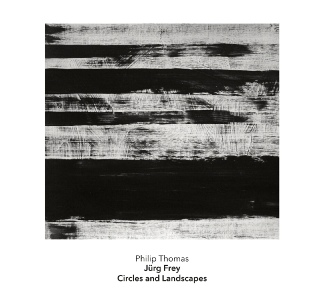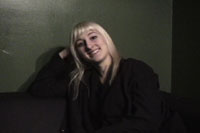Jürg Frey, "Circles and Landscapes"
 Given a little context, a mathematician could tell you what circles and landscapes have in common. They could at least begin by telling you that circles are musical. Traveling counterclockwise around a circle, it is possible to plot the contours of a sine wave on graph paper using a right triangle and a trigonometric ratio, something that is easier to see than to describe. At the same time, circularity is one of those compound notions that can’t be thought all at once. There’s the circularity of arguing in a circle and the circularity of spinning your wheels or going nowhere fast. There’s the circularity of "Frère Jacques" and "Three Blind Mice" and Pachelbel's Canon in D Major, the sense of arriving back at the beginning, and, given a little latitude, the circularity that implies incongruity, the problem of "squaring the circle." All of this to say that there is more to the title of the latest Jürg Frey solo piano collection than abstract poetry. Wrapped up in Philip Thomas’s firm and buoyant performances are ideas about translating music and arranging it and a compositional focus that foregrounds harmony, intentionality, and the voice of one of the world’s most familiar instruments.
Given a little context, a mathematician could tell you what circles and landscapes have in common. They could at least begin by telling you that circles are musical. Traveling counterclockwise around a circle, it is possible to plot the contours of a sine wave on graph paper using a right triangle and a trigonometric ratio, something that is easier to see than to describe. At the same time, circularity is one of those compound notions that can’t be thought all at once. There’s the circularity of arguing in a circle and the circularity of spinning your wheels or going nowhere fast. There’s the circularity of "Frère Jacques" and "Three Blind Mice" and Pachelbel's Canon in D Major, the sense of arriving back at the beginning, and, given a little latitude, the circularity that implies incongruity, the problem of "squaring the circle." All of this to say that there is more to the title of the latest Jürg Frey solo piano collection than abstract poetry. Wrapped up in Philip Thomas’s firm and buoyant performances are ideas about translating music and arranging it and a compositional focus that foregrounds harmony, intentionality, and the voice of one of the world’s most familiar instruments.
Credit should be given to Simon Reynell and everyone involved for the interviews posted to the Another Timbre website with each new album. In addition to being excellent resources on their own, they serve as exceptional liner notes, offering different perspectives on the music without forcing one interpretation or another down anyone’s throat. Gil Sansón and Jürg Frey’s conversation around Circles and Landscapes is a perfect example. In just a few words they complicate the idea of a solo piano record by opening up the writing process behind it. Frey compares composing for piano to composing for stones and leaves and then quickly moves to the question of translating ideas to music. What happens when a thought or an emotion is written down in eighth notes and pitches? Do the formal elements of a piece command an idea or is it the other way around? Is classical harmony a valuable tool or a hindrance that drags music-making into the patterns of the past?
Frey answers those questions in some of the same ways many composers before him have: his music is glassy, pleasant, sometimes eerie, and evocative. It’s emotional, almost romantic, like Erik Satie’s Gnossiennes are, and his sounds sometimes speak as if they contained latent narratives. Other answers come in the form of impenetrable repetitions and minor variations, stretches of music that float in a sea of even strokes and uneven spaces. The formal elements behind the music are difficult to ascertain in many cases because the music itself sounds like it could be improvised. And yet the use of repetition and the way Frey often limits himself to dyads and triads are the hallmarks of a rational process, of a mind that is putting the sounds where they belong. In each of his pieces, Frey balances a delicate combination of intuition and interest.
Time and movement eventually come to the fore just as the title promises, or maybe it’s the lack of time and the lack of movement. Either way, Frey deceives with long passages of static chords and single notes, he deals in illusions by stretching phrases well past the limits of most memories, and he cuts happy resolutions out of the picture even as he conjures his most affecting melodies. Colors, moods, and senses become the dominant elements of the music as the ideas of progression and intent fall away into a drift of endlessly shifting notes.
As paradoxical as it seems, that drift feels like the subject of this collection. All of Frey’s "Circular Music" pieces are numbered, and there’s more than one or two of them extant. There’s "Extended Circular Music No. 2" and "Circular Music No. 5" and, if you look through the rest of his discography, at least six more pieces sharing the same or a similar name, and probably many more still without a recorded home. Some rotate like beacons turning in the night, others hammer away at the silence behind them like a chisel. What they share is more than a compositional sensibility. There’s something more in the way they turn on themselves, transforming from obscure and obtuse to open and permeable and then back again. Frey’s circular writing produces a music that turns dichotomies into spectra, ink and paper into space and time.
samples:
 



